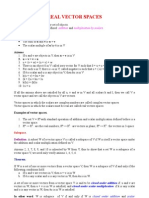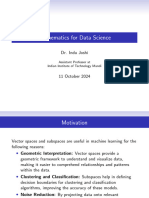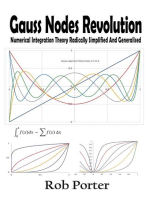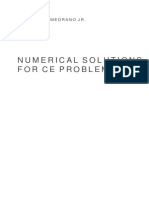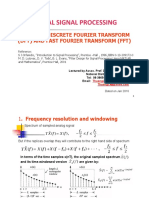Week-3 Session 1
Uploaded by
Vinshi JainWeek-3 Session 1
Uploaded by
Vinshi Jain1
MATHEMATICS FOR DATA SCIENCE II
WEEK 3
Topics covered in week 2
o Some properties of determinants
o Solutions for a system of linear equations
Cramer's rule
where Axi represents the matrix obtained from A by replacing its ith column by the vector b.
Using inverse of a matrix
where 𝑎𝑑𝑗(𝐴) = transpose of cofactor matrix.
Consider a system of linear equations 𝐴𝑥 = 𝑏 where 𝐴 is an invertible matrix. Then
solution of the system of linear equations can be obtain as follows:
Step 1: Find the inverse of the matrix A.
Step 2: Find the matrix multiplication of A−1 with b, i.e. A −1b which is a column
matrix.
Step 3: Compare with the column matrix x and find the value of x 1, x2, . . .,xn.
Instructor: Dr. Lavanya S
2
Row reduction
Row echelon form:
Reduced row echelon form:
Dependent and independent variables
Dependent variable - column containing leading entry
Independent variable - column not containing any leading entry
Guassian elimination method
Step 1: Write the system of linear equations in the form Ax=b (where A is an mxn
matrix) and form the augmented matrix [A|b]
Step 2: Perform elementary row operations on [A|b] so that A is converted to the
RREF form
Instructor: Dr. Lavanya S
3
Step 3: After obtaining the reduced row echelon form the matrix [A|b], let R be the
submatrix of the obtained matrix of the first n columns and c be the submatrix of the
obtained matrix consisting of the last column. We can write reduced row echelon form
of [A|b] to [R|c].
Step-4: Form the corresponding system of linear equations Rx = c.
Step-5: Find all the solutions of Rx = c. These are also the solutions of Ax = b.
Augumented matrix [A|b]
converted to which is of the form [Rx|c]
(fixed values or it depends on the independent
variable)
Instructor: Dr. Lavanya S
4
TOPICS TO BE COVERED IN WEEK 3
Motivation for Vector Spaces
Vector Spaces
Properties of Vector Spaces
Subspaces
Linear combination
Linear dependence Note: Please don't confuse linear dependence and independence with
dependent and independent variable
Linear Independence
S is Closed under addition if addition of any two elements of S is also in S.
Motivation for vector spaces:
Consider a system of linear equations Ax = b. We have seen a few ways of identifying
solutions of this system. Let S = {x ϵ Rn | Ax = 0}. That is, S is the set of all solutions of the
system Ax = 0.
What do we know about S?
S is always _____________ and it contains the _______ vector.
S is either a ____________ set or it contains ________________________ elements.
Let us assume the case when S is an infinite set. Observe that
(1) if v1, v2 ϵ S, then v1 +v2 ϵS. (Closed under addition)
(2) if αϵR and v1 ϵ S, then αv1ϵS. (Closed under scalar multiplication)
Exercises: Closed under vector addition and scalar multiplication
a) S = { (x, 0) : x ϵ R}
closed under addition and
scalar multiplication
b) S = {(x , y, 1) : x, y ϵ R}
not closed under addition and scalar multiplication
c) S = {(x,y) ϵ R2: x+y = 1}
not closed under addition and scalar
multiplication
d) S= {(x,y,z)ϵ R3 : x+y+z = 0}
closed under addition and scalar multiplication
Instructor: Dr. Lavanya S
5
Equivalently, if v1 and v2 are in S then α1v1 + α2v2 is also in S, where α1 and α2 are real
numbers. We call α1v1 + α2v2 a linear combination of v1 and v2. In more general, if v1, v2, .
. . , vn ∈ S and α1, α2, . . . , αn ∈ R, then α1v1 + α2v2 + · · · + αnvn ( linear combination of v1,
v2, . . . , vn) is also in S.
Roughly, we can think of a vector space V as a collection of objects that behave similar to
the vectors in the set S. We can perform two operations on V ;
• We can add the elements of V .
• We can multiply scalars (α ∈ R) with the elements of V . These operations should satisfy
a few conditions, the axioms for a vector space.
Properties of vectors in R2
(1,2)
v1
v3 v2 (2, 1)
(-1, 1)
v1= v2= v3=
Instructor: Dr. Lavanya S
6
v1+v2 = v2+ v1= Commutative (addition)
(v1+v2)+v3 = v1+(v2+v3) = Associative(addition)
Let v be any vector in R2.
Find a vector such that when it is added to v, the sum is still v.
Zero vector - identity
v + __ = v
Find a vector such that when it is added to v, the sum is the zero vector.
v + __ = 0 (what is 0 here?) additive inverse
1(v1) =
2(3v1) = (2.3)v1 = (associative - scalar multiplication)
2(v1 + v2) = 2.v1+ 2.v2=
Distributive properties
(2+3).v1 = 2.v1+ 3.v1 =
Vector Spaces
Always first check additive and multiplicative closure
that satisfies the following conditions:
Note: It is also represented as (V ; +; ·; R)
If there is no additive identity, we cannot define an additive inverse.
Instructor: Dr. Lavanya S
7
Note: Every vector space has the zero element.
• To prove a set is a vector space, we need to verify additive and multiplicative closure
and all the other axioms given above.
• If just one of the vector space axiom fails to hold, then V not a vector space.
• Zero element 0V of a vector space V is always unique. • The real number 0 ∈ R and the
zero vector 0V of a vector space V are commonly denoted by the symbol 0. One can
always tell from the context whether 0 means the zero scalar (0 ∈ R) or the zero vector
(0V ∈ V ).
• It is standard to suppress · and only write au instead of a · u.
A vector is an element of a vector space.
Examples:
1) Rn
Instructor: Dr. Lavanya S
8
2) The set of all m×n matrices with real entries, Mm×n
HW: verify the other axioms
3) Solutions of a Homogeneous system Ax=0 where A is an m×n matrix. (i.e. a system
with m equations and n variables)
HW: Verify the other axioms
Note: This space is a subset of Rn and hence is a subspace of Rn.
4) Let V = R2 = {(x1, x2) | x1, x2 ∈ R}, and the addition and scalar multiplication on V are
defined as follows:
Closed under addition and scalar multilplication
V is not commutative w.r.t addition and hence not a vector space
Instructor: Dr. Lavanya S
9
5) Consider the set V = {(x, 1) | x ∈ R}. The addition and scalar multiplication on V is
defined as follows:
Closed under addition and scalar multiplication
Check whether V is a vector space or not with respect to the given operations.
Instructor: Dr. Lavanya S
Suppose V={(x, y) : x+ y =1} = {(x, 1-x) x in R} 10
We will check if there is a vector (a, b) such that for an arbitrary vector (x1,x2) in R2,
There is no additive identity. So (iii) fails.
hence (iv) also fails.
hence (v) fails
Closed under addition and scalar multiplication
Instructor: Dr. Lavanya S
11
V1 is not a vector space since it is not commutative (w.r.t. addition)
V2 is not a vector space since it is not commutative.
V3 has no additive identity and hence it is not a vector space.
Instructor: Dr. Lavanya S
12
HW: Consider the set V = R2 = {(x, y) | x, y ∈ R}. The addition and scalar multiplication on
V are defined as follows:
Prove that V is a vector space.
Exercise: Assuming that V is vector space, find the identity element.
Note: You can see that (0, 0) is not always a zero vector of R 2. The zero vector is an
element of the set you are working with which satisfies the corresponding axioms
Instructor: Dr. Lavanya S
13
Instructor: Dr. Lavanya S
14
Properties
Suppose there are two vectors and satisfying the axiom (iii)
Instructor: Dr. Lavanya S
15
Subspaces
A non-empty subset W of a vector space V is called a subspace of V if W is a vector space
under the operations addition and scalar multiplication defined in V.
To show that a non-empty set W is a vector subspace, one doesn’t need to check all the
vector space axioms.
Conditions for a subspace:
If W is a non-empty subset of a vector space V , then W is a subspace of V if and only if
the following conditions hold (1) If w1 and w2 are in W , then w1 + w2∈ W .
(2) For all c ∈ R and for all w1 ∈W , c · w1∈ W .
A subspace W of a vector space V is called a proper subspace if W ⊊ V.
X= {1, 2, 3}. Trivial subsets = ,X
Note:
Every vector space V over R has two trivial subspaces:
• V itself is a subspace of V .
• The subset consisting of the zero vector {0V} of V is also a subspace of V.
Examples:
1) Check whether W = {(x, y) | x + y = 0} ⊂ R2 is a vector subspace of V = R2 or not.
W is closed under addition and scalar multiplication.
Instructor: Dr. Lavanya S
16
Geometrically, the set W represents a straight line in R2. The geometrical representation
of W is given below.
From the above graph, it is clear that the line L passes through the origin. In general, a
line in R2 is a subspace of R2 if and only if it passes through the origin.
Note: The non-trivial subspaces of R2 are given by the straight lines passing
through origin.
2)Consider the parabola W = {(x, y) | y = x2} ⊂ V = R2. We want to check whether W is a
vector subspace of V or not.
Not closed under addition
Not closed under scalar multiplication.
Hence W is not a vector subspace of R2.
Instructor: Dr. Lavanya S
17
3) Check whether the set W = {A ∈ M2×2(R) | A = AT } of all 2 × 2 real symmetric matrices is
a subspace of M2×2(R) or not with standard addition and scalar multiplication.
W is closed under addition and scalar multiplication and hence is a subspace
4) Check whether the set W of 2 × 2 invertible matrices with real entries with standard
addition and scalar multiplication is a subspace of M 2×2(R) or not.
It is not closed under addition.
W is not a subspace.
5) Show that W = {(0, y, z) : y, z ∈ R} is a subspace of real vector space R3, where R3 is a
vector space with respect to the usual addition and scalar multiplication.
Instructor: Dr. Lavanya S
18
6) Show that the plane W = {(x, y, z) | x + y + z = 1} ⊂ R3 is not a vector subspace of R3,
where R3 is a vector space with respect to the usual addition and scalar multiplication .
If we are considering usual addition and scalar multiplication, then the origin
should be there in the subspace.
Here (0,0,0) does not belong to W. Hence W is not a subspace.
7) Let W = {(x, y, z) | x ≥ z} be a subset of the vector space R 3 (with respect to the usual
addition and scalar multiplication). Then show that W is not a vector subspace of R3.
Let us consider the vector (1, 0, 0). It is en element of W.
-1(1, 0, 0) = (-1, 0 , 0) is not element of W.
W is not closed under scalar multiplication.
Instructor: Dr. Lavanya S
19
Write down all possible subspaces of R 2 and R3.
: R3, {0}
All lines passing through origin
All planes passing through origin.
Take any two subspaces W1 and W2 of V. W1 W2 always contains the zero
vector.
Instructor: Dr. Lavanya S
You might also like
- Math 415 - Lecture 9: 1 Inverse of A Matrix (CNTD.)No ratings yetMath 415 - Lecture 9: 1 Inverse of A Matrix (CNTD.)8 pages
- Vector Spaces: C Michael C. Sullivan, Fall 2005No ratings yetVector Spaces: C Michael C. Sullivan, Fall 20055 pages
- 5.2 Vector spaces, linearly independent, dependent, basisNo ratings yet5.2 Vector spaces, linearly independent, dependent, basis16 pages
- Lec3 - Vector Spaces and Linear IndependenceNo ratings yetLec3 - Vector Spaces and Linear Independence23 pages
- MTPDF6 Introduction to Vector Space (1)No ratings yetMTPDF6 Introduction to Vector Space (1)67 pages
- Modul 5-a_General Vector Space and Subspace-editedAruni englishNo ratings yetModul 5-a_General Vector Space and Subspace-editedAruni english59 pages
- Student's Solutions Manual and Supplementary Materials for Econometric Analysis of Cross Section and Panel Data, second editionFrom EverandStudent's Solutions Manual and Supplementary Materials for Econometric Analysis of Cross Section and Panel Data, second editionNo ratings yet
- Gauss Nodes Revolution: Numerical Integration Theory Radically Simplified And GeneralisedFrom EverandGauss Nodes Revolution: Numerical Integration Theory Radically Simplified And GeneralisedNo ratings yet
- Linear Algebra, 4th Edition (2009) Lipschutz-Lipson100% (2)Linear Algebra, 4th Edition (2009) Lipschutz-Lipson432 pages
- Matrices and Determinants 40 Slides PresentationNo ratings yetMatrices and Determinants 40 Slides Presentation36 pages
- Secondary Schools - Advanced Mathematics - Teacher's Book - Senior FiveNo ratings yetSecondary Schools - Advanced Mathematics - Teacher's Book - Senior Five240 pages
- USAF Test Pilot School Flying QualitiesTextbook Volume 2 Part 1100% (3)USAF Test Pilot School Flying QualitiesTextbook Volume 2 Part 1704 pages
- Cartesian Impedance Control of Redundant Robots: Recent Results With The DLR-Light-Weight-ArmsNo ratings yetCartesian Impedance Control of Redundant Robots: Recent Results With The DLR-Light-Weight-Arms6 pages
- Csec Mathematics Past Paper Solution - Jan 2008: Cxcdirect InstituteNo ratings yetCsec Mathematics Past Paper Solution - Jan 2008: Cxcdirect Institute12 pages
- Problems and Theorems in Linear Algebra - V. Prasolov PDFNo ratings yetProblems and Theorems in Linear Algebra - V. Prasolov PDF228 pages
- Iris Diagnosis - A Quantitative Non-Invasive Tool Fordiabetes DetectionNo ratings yetIris Diagnosis - A Quantitative Non-Invasive Tool Fordiabetes Detection7 pages
- Department of Mathematics Central University of Tamil Nadu, ThiruvarurNo ratings yetDepartment of Mathematics Central University of Tamil Nadu, Thiruvarur53 pages
- Course Outline, College Algebra, Fall 2020, BBA-I (AB)No ratings yetCourse Outline, College Algebra, Fall 2020, BBA-I (AB)4 pages
- System of Linear Equations: Direct & Iterative MethodsNo ratings yetSystem of Linear Equations: Direct & Iterative Methods36 pages
- American International University-Bangladesh (AIUB) : Summer 2019-2020 SEMESTER I. Course Core and TitleNo ratings yetAmerican International University-Bangladesh (AIUB) : Summer 2019-2020 SEMESTER I. Course Core and Title11 pages
- Matrix Inversion: Determinants Inverses Pages 68 - 77No ratings yetMatrix Inversion: Determinants Inverses Pages 68 - 7719 pages
- Differential Equations and Linear Algebra Supplementary NotesNo ratings yetDifferential Equations and Linear Algebra Supplementary Notes17 pages
- Math 415 - Lecture 9: 1 Inverse of A Matrix (CNTD.)Math 415 - Lecture 9: 1 Inverse of A Matrix (CNTD.)
- 5.2 Vector spaces, linearly independent, dependent, basis5.2 Vector spaces, linearly independent, dependent, basis
- Modul 5-a_General Vector Space and Subspace-editedAruni englishModul 5-a_General Vector Space and Subspace-editedAruni english
- An Introduction to Linear Algebra and TensorsFrom EverandAn Introduction to Linear Algebra and Tensors
- Student's Solutions Manual and Supplementary Materials for Econometric Analysis of Cross Section and Panel Data, second editionFrom EverandStudent's Solutions Manual and Supplementary Materials for Econometric Analysis of Cross Section and Panel Data, second edition
- Gauss Nodes Revolution: Numerical Integration Theory Radically Simplified And GeneralisedFrom EverandGauss Nodes Revolution: Numerical Integration Theory Radically Simplified And Generalised
- Linear Algebra, 4th Edition (2009) Lipschutz-LipsonLinear Algebra, 4th Edition (2009) Lipschutz-Lipson
- Secondary Schools - Advanced Mathematics - Teacher's Book - Senior FiveSecondary Schools - Advanced Mathematics - Teacher's Book - Senior Five
- USAF Test Pilot School Flying QualitiesTextbook Volume 2 Part 1USAF Test Pilot School Flying QualitiesTextbook Volume 2 Part 1
- Cartesian Impedance Control of Redundant Robots: Recent Results With The DLR-Light-Weight-ArmsCartesian Impedance Control of Redundant Robots: Recent Results With The DLR-Light-Weight-Arms
- Csec Mathematics Past Paper Solution - Jan 2008: Cxcdirect InstituteCsec Mathematics Past Paper Solution - Jan 2008: Cxcdirect Institute
- Problems and Theorems in Linear Algebra - V. Prasolov PDFProblems and Theorems in Linear Algebra - V. Prasolov PDF
- Iris Diagnosis - A Quantitative Non-Invasive Tool Fordiabetes DetectionIris Diagnosis - A Quantitative Non-Invasive Tool Fordiabetes Detection
- Department of Mathematics Central University of Tamil Nadu, ThiruvarurDepartment of Mathematics Central University of Tamil Nadu, Thiruvarur
- Course Outline, College Algebra, Fall 2020, BBA-I (AB)Course Outline, College Algebra, Fall 2020, BBA-I (AB)
- System of Linear Equations: Direct & Iterative MethodsSystem of Linear Equations: Direct & Iterative Methods
- American International University-Bangladesh (AIUB) : Summer 2019-2020 SEMESTER I. Course Core and TitleAmerican International University-Bangladesh (AIUB) : Summer 2019-2020 SEMESTER I. Course Core and Title
- Matrix Inversion: Determinants Inverses Pages 68 - 77Matrix Inversion: Determinants Inverses Pages 68 - 77
- Differential Equations and Linear Algebra Supplementary NotesDifferential Equations and Linear Algebra Supplementary Notes









